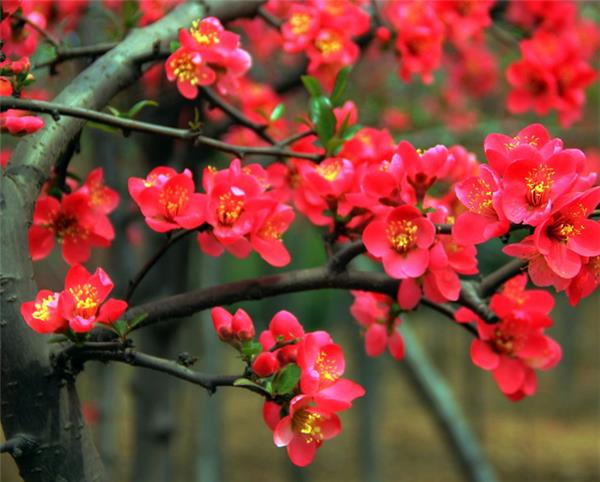The planting method of crabapple flower
Crabapple flower has been a famous flower appreciated by both elegant and popular people since ancient times. It blossoms like brocade and is known as "Guoyan". Today we would like to introduce to you the planting method of crabapple flower. Let's take a look!

The planting method of crabapple flower
1. Requirements for temperature and light. Begonia flowers like the sun, suitable for growing in a sunny environment, in a cool place it will grow badly. Family-raised potted plants should be taken care of in a well-lit place when they are in the growing period. Because of the resistance to cold, crabapple flowers can grow well when it is minus 15 degrees in winter, will not suffer frost damage, and can be put outdoors for the winter. However, when the cold is abnormal, protective measures should be taken.
2. Requirements for watering and fertilization. Crabapple flowers should be watered and fertilized together. In autumn, after the leaves fall, they must apply a large amount of fertilizer to replenish their lost nutrients so that they can stay healthy. When the spring buds sprout, they should apply organic fertilizer once and water it once. Fertilization should be different depending on the age of the tree. However, crabapple flowers are also famous for their resistance to drought, so do not water too much at ordinary times, and avoid stagnant water in the soil, otherwise excessive moisture will lead to rotten roots and yellow leaves.

3. Pruning should be in early spring. Begonia flowers can be pruned from defoliation to sprouting in early spring to cut off withered branches, disease and insect branches to keep the crown open, ventilated and transparent. In order to promote the vigorous flowering of the plant, the long branches should be cut short, so that the remaining axillary buds can get more nutrition, so as to reduce the nutrient consumption and form more flowering and fruiting branches. During the growth period, if the heart can be removed in time and the vegetative growth is restricted in the early stage, the effect will be more significant.

Begonia likes sunshine, is not tolerant to shade, has strong adaptability to cold and dry climate, and avoids dampness. When cultivating potted crabapple flowers, you need to pay attention to the following.
1. Put it in a sunny place, but if the sun is poisonous at noon in summer, you should give some shelter to avoid burning the flowers and leaves.
2. Crabapple flowers need relatively loose soil, and need to contain some alkaline, probably the soil ph value is not less than 7, you can choose the soil at the bottom of the flower bed or tree, and then add 1/3 river sand.
3. The depth of crabapple flowers planted in the pot should not be too deep, so that the root system can be well extended, and it is better to load it at a depth of 12 meters from the bottom of the pot, but it depends on the plant size.
4, the specific watering should depend on the weather, should keep the basin soil moist, but can not accumulate water, had better not be caught in the rain, lest too much water lead to rotten roots, do not water when too cold.

5. when the spring buds sprout, we should apply some organic fertilizer to supplement nutrients and water once. Apply organic fertilizer when falling leaves in autumn, also cooperate with watering once, apply phosphorus and potassium fertilizer after flower fade, you can buy some special fertilizer for begonia every day, and fertilize properly according to the instructions.
6. Begonia can be placed in a ventilated place such as the courtyard or balcony. Begonia is more hardy, so it can be kept outside in winter, but if it is particularly cold, some anti-freezing measures should be taken.
7. in order to ensure that the plant can blossom vigorously, pruning branches and leaves should be carried out from defoliation to early spring sprouting, which can subtract weak branches, branches and leaves of diseases and insect pests, individual longer branches and leaves, overdense branches and leaves, and vertical pruning of sparse branches to promote its multiple lateral branches.
In addition, if the begonia plant grows up, the pot needs to be changed in time, so as not to affect the growth of begonia.
Related
- Wuhan Hospital Iron Tree Blooming Result Was Instantly Frightened by the Gardener Master
- Which variety of camellia is the most fragrant and best? Which one do you like best?
- What is the small blue coat, the breeding methods and matters needing attention of the succulent plant
- Dormancy time and maintenance management of succulent plants during dormancy
- Minas succulent how to raise, Minas succulent plant pictures
- What are the varieties of winter succulent plants
- How to raise succulent plants in twelve rolls? let's take a look at some experience of breeding twelve rolls.
- Attention should be paid to water control for succulent plants during dormant period (winter and summer)
- Watering experience of twelve rolls of succulent plants
- Techniques for fertilizing succulent plants. An article will let you know how to fertilize succulent plants.



